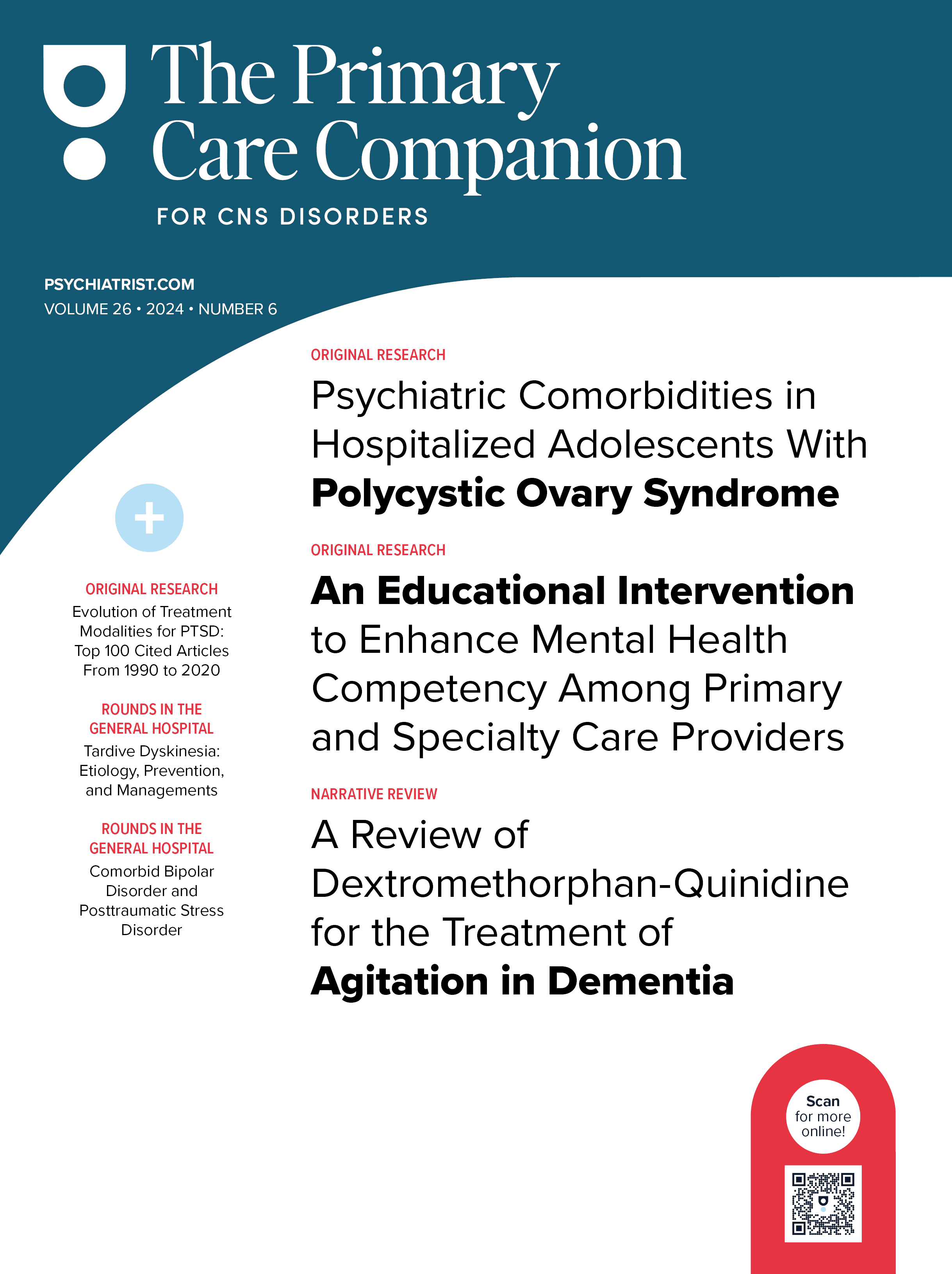
Prim Care Companion CNS Disord 2022;24(3):21cr03135
To cite: Sidana A, Goel V. Benzodiazepine withdrawal catatonia: a diagnostic intervention. Prim Care Companion CNS Disord. 2022;24(3):21cr03135.
To share: https://doi.org/10.4088/PCC.21cr03135
© 2022 Physicians Postgraduate Press, Inc.
aDepartment of Psychiatry, Government Medical College and Hospital, Chandigarh, India
*Corresponding author: Ajeet Sidana, MD, Department of Psychiatry, Level-5, Block-D, Sector-32, Government Medical College and Hospital, Chandigarh, India ([email protected]).
Catatonia is a complex psychomotor syndrome. The exact mechanisms underlying the pathophysiology of catatonia remain a mystery. Benzodiazepine withdrawal is known to cause nausea, tremors, postural hypotension, malaise, psychomotor agitation, anxiety, insomnia, irritability, palpitations, headache, hallucinations, seizures, and delirium.1 There are case reports2,3 of benzodiazepine withdrawal catatonia in schizoaffective disorder and older individuals. Here, we report the case of a young man with history of polysubstance use who presented with benzodiazepine withdrawal symptoms with predominant catatonic features and responded well to intravenous lorazepam.
Case Report
A 28-year-old man presented with history of use of alcohol, opioids in the form of tramadol, cannabis, benzodiazepines, cough syrups, and tobacco for the past 10 years. The intake of alcohol, opiates, and cannabis had been in a harmful pattern. The patient had never tried abstinence in the past and had engaged in risky behaviors to overcome craving.
He presented to the emergency department with complaints of sudden loss of consciousness, involuntary movements of limbs associated with rigidity, uprolling of eyes, and deviation of angle of the mouth. A brief history was obtained from family members, following which laboratory investigations including hemogram, renal function tests with serum electrolytes, liver function tests, blood sugar, thyroid profile, vitamin D and B12, HIV, HCV, and hepatitis B surface antigen and noncontrast computed tomography of the head were conducted, and the results were within normal limits. A provisional diagnosis of withdrawal seizures (alcohol and/or benzodiazepine) was made. He was managed by the emergency treating team with a loading dose of antiepileptics (injection phenytoin), and the same was continued in oral formulations thereafter. Following the initiation of treatment, no seizure episode was observed. As the general condition of the patient did not improve with ongoing treatment, psychiatry liaison was sought on the subsequent day. At the time of psychiatric evaluation, the patient was found to be extremely hypoactive, was mute, and exhibited staring, rigidity, withdrawal, posturing, and autonomic abnormality. A drug screen urinalysis was positive for benzodiazepines. As the history and laboratory findings were suggestive of benzodiazepine withdrawal catatonia, the patient was evaluated with the Bush Francis Catatonia Rating Scale (BFCRS),4 which yielded a score of 17. Injection lorazepam 2 mg slow intravenous was given, following which the patient responded dramatically and showed improvement in mutism, staring, posturing, and rigidity. His BFCRS score decreased to 7, and the diagnosis of benzodiazepine withdrawal catatonia was established.
After the patient started responding to treatment, he provided his history of benzodiazepine (tablet alprazolam 0.5 mg 50–60 tablets/day) and opioid (tablet tramadol 50 mg 4–5 tablets/day) intake in a dependent pattern. Nonavailability of both drugs led to sudden cessation, following which 2 days later the patient had withdrawal seizures that eventually progressed to catatonia, further confirming the diagnosis of benzodiazepine withdrawal catatonia. The patient was then assessed for dependence using the Benzodiazepine Dependence Questionnaire,5 Severity of Opioid Dependence Questionnaire,6 and Fagerström Test for Nicotine Dependence.7 Findings were suggestive of severe dependence on benzodiazepines (total score of 34/42), moderate dependence on nicotine (total score of 4), and mild dependence on opioids (total score of 9).
Discussion
Our patient had a history of dependent use of tramadol and alprazolam and presented with catatonia proceeded by withdrawal seizure. Catatonia is not a common presentation of benzodiazepine or tramadol withdrawal. Alterations of cerebral motor circuits and dysregulation of γ-aminobutyric acid (GABA), dopamine, glutamate, and serotonin (5-HT1) neurotransmission have been implicated in catatonia.1 The patient’s dramatic response to benzodiazepines suggests a crucial role of abnormal GABA neurotransmission in patients with catatonia. Tramadol is a centrally acting selective agonist of μ receptors and preferentially inhibits the reuptake of serotonin and norepinephrine.8 Therefore, the likelihood of benzodiazepines leading to withdrawal seizures and catatonia in our patient is high. This case highlights the need to collect information and urine screening for benzodiazepines in patients presenting with catatonia to avoid unnecessary labeling of affective illness.
Published online: June 23, 2022.
Relevant financial relationships: None.
Funding/support: None.
Patient consent: Consent was received from the patient to publish the case report, and information has been de-identified to protect anonymity.
References (8)

- Walther S, Stegmayer K, Wilson JE, et al. Structure and neural mechanisms of catatonia. Lancet Psychiatry. 2019;6(7):610–619. PubMed CrossRef
- Lebin LG, Cerimele JM. Recurrent benzodiazepine withdrawal catatonia in an older adult. Am J Psychiatry. 2017;174(10):1001–1002. PubMed CrossRef
- Mader EC Jr, Rathore SH, England JD, et al. Benzodiazepine withdrawal catatonia, delirium, and seizures in a patient with schizoaffective disorder. J Investig Med High Impact Case Rep. 2020;8:2324709620969498. PubMed CrossRef
- Bush G, Fink M, Petrides G, et al. Catatonia, I: rating scale and standardized examination. Acta Psychiatr Scand. 1996;93(2):129–136. PubMed CrossRef
- Minaya O, Fresán A, Cortes-Lopez JL, et al. The Benzodiazepine Dependence Questionnaire (BDEPQ): validity and reliability in Mexican psychiatric patients. Addict Behav. 2011;36(8):874–877. PubMed CrossRef
- Sutherland G, Edwards G, Taylor C, et al. The measurement of opiate dependence. Br J Addict. 1986;81(4):485–494. PubMed CrossRef
- Heatherton TF, Kozlowski LT, Frecker RC, et al. The Fagerström Test for Nicotine Dependence: a revision of the Fagerström Tolerance Questionnaire. Br J Addict. 1991;86(9):1119–1127. PubMed CrossRef
- Klotz U. Tramadol: the impact of its pharmacokinetic and pharmacodynamic properties on the clinical management of pain. Arzneimittelforschung. 2003;53(10):681–687. PubMed
Please sign in or purchase this PDF for $40.
Save
Cite




